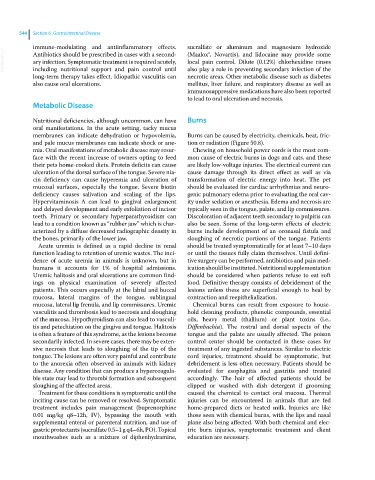Page 576 - Clinical Small Animal Internal Medicine
P. 576
544 Section 6 Gastrointestinal Disease
immune‐modulating and antiinflammatory effects. sucralfate or aluminum and magnesium hydroxide
VetBooks.ir Antibiotics should be prescribed in cases with a second (Maalox®, Novartis), and lidocaine may provide some
local pain control. Dilute (0.12%) chlorhexidine rinses
ary infection. Symptomatic treatment is required acutely,
including nutritional support and pain control until
necrotic areas. Other metabolic disease such as diabetes
long‐term therapy takes effect. Idiopathic vasculitis can also play a role in preventing secondary infection of the
also cause oral ulcerations. mellitus, liver failure, and respiratory disease as well as
immunosuppressive medications have also been reported
to lead to oral ulceration and necrosis.
Metabolic Disease
Nutritional deficiencies, although uncommon, can have Burns
oral manifestations. In the acute setting, tacky mucus
membranes can indicate dehydration or hypovolemia, Burns can be caused by electricity, chemicals, heat, fric
and pale mucus membranes can indicate shock or ane tion or radiation (Figure 50.8).
mia. Oral manifestations of metabolic disease may resur Chewing on household power cords is the most com
face with the recent increase of owners opting to feed mon cause of electric burns in dogs and cats, and these
their pets home‐cooked diets. Protein deficits can cause are likely low‐voltage injuries. The electrical current can
ulceration of the dorsal surface of the tongue. Severe nia cause damage through its direct effect as well as via
cin deficiency can cause hyperemia and ulceration of transformation of electric energy into heat. The pet
mucosal surfaces, especially the tongue. Severe biotin should be evaluated for cardiac arrhythmias and neuro
deficiency causes salivation and scaling of the lips. genic pulmonary edema prior to evaluating the oral cav
Hypervitaminosis A can lead to gingival enlargement ity under sedation or anesthesia. Edema and necrosis are
and delayed development and early exfoliation of incisor typically seen in the tongue, palate, and lip commissures.
teeth. Primary or secondary hyperparathyroidism can Discoloration of adjacent teeth secondary to pulpitis can
lead to a condition known as “rubber jaw” which is char also be seen. Some of the long‐term effects of electric
acterized by a diffuse decreased radiographic density in burns include development of an oronasal fistula and
the bones, primarily of the lower jaw. sloughing of necrotic portions of the tongue. Patients
Acute uremia is defined as a rapid decline in renal should be treated symptomatically for at least 7–10 days
function leading to retention of uremic wastes. The inci or until the tissues fully claim themselves. Until defini
dence of acute uremia in animals is unknown, but in tive surgery can be performed, antibiotics and pain med
humans it accounts for 1% of hospital admissions. ication should be instituted. Nutritional supplementation
Uremic halitosis and oral ulcerations are common find should be considered when patients refuse to eat soft
ings on physical examination of severely affected food. Definitive therapy consists of debridement of the
patients. This occurs especially at the labial and buccal lesions unless these are superficial enough to heal by
mucosa, lateral margins of the tongue, sublingual contraction and reepithelialization.
mucosa, lateral lip frenula, and lip commissures. Uremic Chemical burns can result from exposure to house
vasculitis and thrombosis lead to necrosis and sloughing hold cleaning products, phenolic compounds, essential
of the mucosa. Hypothyroidism can also lead to vasculi oils, heavy metal (thallium) or plant toxins (i.e.,
tis and petechiation on the gingiva and tongue. Halitosis Diffenbachia). The rostral and dorsal aspects of the
is often a feature of this syndrome, as the lesions become tongue and the palate are usually affected. The poison
secondarily infected. In severe cases, there may be exten control center should be contacted in these cases for
sive necrosis that leads to sloughing of the tip of the treatment of any ingested substances. Similar to electric
tongue. The lesions are often very painful and contribute cord injuries, treatment should be symptomatic, but
to the anorexia often observed in animals with kidney debridement is less often necessary. Patients should be
disease. Any condition that can produce a hypercoagula evaluated for esophagitis and gastritis and treated
ble state may lead to thrombi formation and subsequent accordingly. The hair of affected patients should be
sloughing of the affected areas. clipped or washed with dish detergent if grooming
Treatment for these conditions is symptomatic until the caused the chemical to contact oral mucosa. Thermal
inciting cause can be removed or resolved. Symptomatic injuries can be encountered in animals that are fed
treatment includes pain management (buprenorphine home‐prepared diets or heated milk. Injuries are like
0.01 mg/kg q8–12h, IV), bypassing the mouth with those seen with chemical burns, with the lips and nasal
supplemental enteral or parenteral nutrition, and use of plane also being affected. With both chemical and elec
gastric protectants (sucralfate 0.5–1 g q4–6h, PO). Topical tric burn injuries, symptomatic treatment and client
mouthwashes such as a mixture of diphenhydramine, education are necessary.

